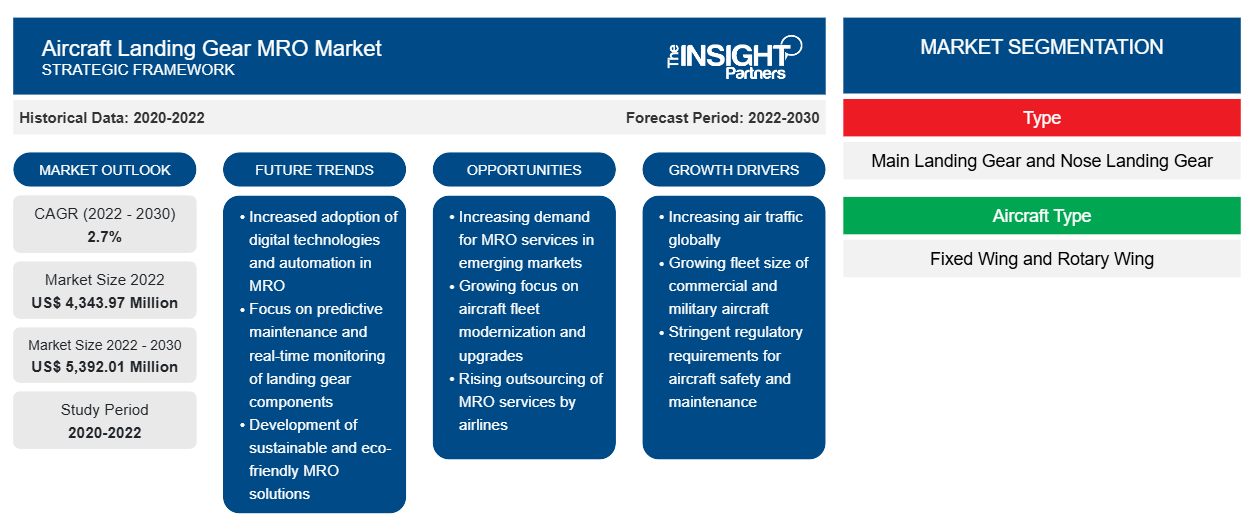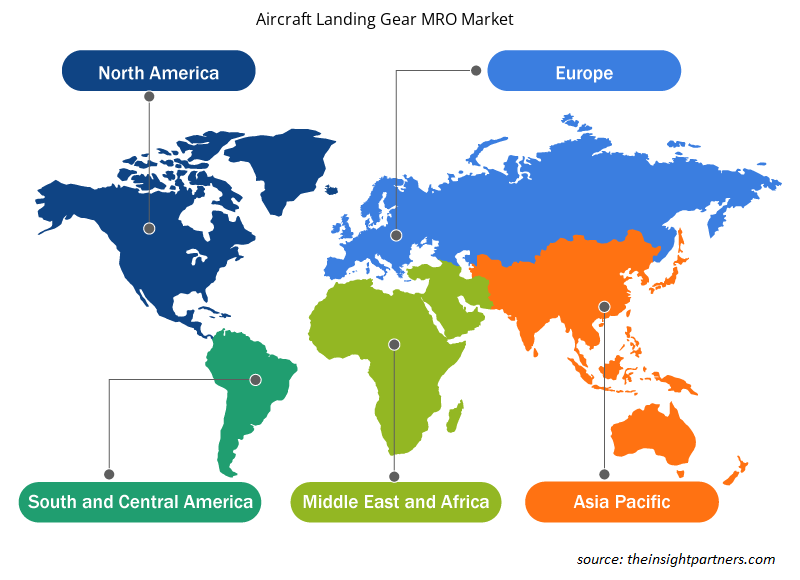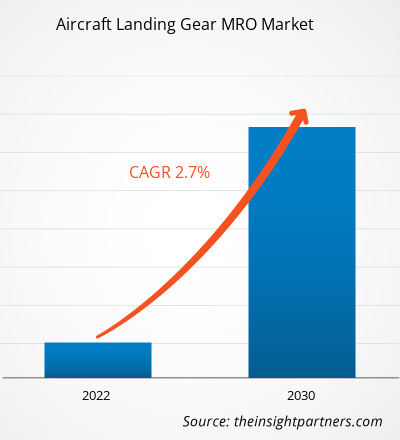[Rapport de recherche] La taille du marché MRO des trains d'atterrissage d'aéronefs a été évaluée à 4 343,97 millions USD en 2022 et devrait atteindre 5 392,01 millions USD d'ici 2030 ; on estime qu'elle enregistrera un TCAC de 2,7 % de 2022 à 2030. Les prévisions du marché MRO des trains d'atterrissage d'aéronefs sont estimées sur la base de divers résultats de recherche secondaires et primaires tels que les publications clés de l'entreprise, les données d'association et les bases de données.
Point de vue de l'analyste :
Le marché de la maintenance et de la réparation des trains d'atterrissage des avions a connu une croissance lente au cours des dernières années. Cela est principalement dû au ralentissement des opérations aériennes dans le monde entier causé par la pandémie de COVID-19. En outre, la reprise de l'industrie aérienne connaît une croissance lente en termes de demande de maintenance et de réparation des trains d'atterrissage. Cependant, l'un des principaux facteurs qui stimulent le marché est l'augmentation du trafic aérien de passagers dans différentes régions. Un autre facteur majeur qui stimule la croissance du marché est l'augmentation du nombre de flottes d'avions mondiales, ce qui génère en fin de compte une nouvelle demande de services de maintenance et de réparation des trains d'atterrissage auprès de différentes compagnies aériennes du monde entier.
Aperçu du marché :
Le marché de la maintenance et de la réparation des trains d'atterrissage des avions devrait connaître une croissance stable dans les années à venir. Cependant, le marché est modérément fragmenté, avec la présence d'un grand nombre d'acteurs opérant dans différentes régions. De plus, les livraisons attendues d'avions commerciaux au cours des 20 prochaines années devraient générer de nouvelles opportunités pour les fournisseurs du marché au cours de la période de prévision. Selon les principaux constructeurs d'avions, à savoir Airbus et Boeing, plus de 40 000 avions commerciaux devraient être livrés d'ici la fin de 2042. En outre, la croissance des achats d'avions militaires renforce le marché de la maintenance et de la réparation des trains d'atterrissage des avions dans différentes régions. En outre, les tensions constantes entre des pays tels que la Russie-Ukraine, la Chine-Taïwan, Israël-Palestine, les États-Unis-Chine, l'Inde-Pakistan, l'Inde-Chine, etc., encouragent également l'achat d'avions et d'hélicoptères militaires. Ces tensions entre les pays sont dues à la concurrence géopolitique croissante entre différents pays pour renforcer leurs forces armées respectives pour lesquelles ils achètent des technologies de pointe et ajoutent de la valeur à leurs forces aériennes respectives. Ces facteurs ont poussé le déploiement d’avions militaires, d’hélicoptères et de drones en plus grand nombre, ce qui catalyse davantage le marché MRO des trains d’atterrissage d’avions dans différentes régions.
Personnalisez ce rapport en fonction de vos besoins
Vous bénéficierez d'une personnalisation gratuite de n'importe quel rapport, y compris de certaines parties de ce rapport, d'une analyse au niveau des pays, d'un pack de données Excel, ainsi que d'offres et de remises exceptionnelles pour les start-ups et les universités.
Marché de la maintenance et de la réparation des trains d'atterrissage des avions : informations stratégiques

- Obtenez les principales tendances clés du marché de ce rapport.Cet échantillon GRATUIT comprendra une analyse de données, allant des tendances du marché aux estimations et prévisions.
Moteur du marché :
Le nombre croissant de contrats de maintenance et de réparation de trains d'atterrissage stimule la croissance du marché de la maintenance et de réparation de trains d'atterrissage d'avions
Plusieurs compagnies aériennes opérant dans différentes régions ont collaboré avec différents acteurs de la MRO pour prolonger leurs contrats existants ou pour leur fournir de nouveaux contrats de MRO pour les trains d'atterrissage. Quelques exemples sont mentionnés ci-dessous :
- En février 2024, Liebherr-Aerospace et Japan Airlines (JAL) ont signé un contrat de service à long terme pour la révision des trains d'atterrissage.
- En octobre 2023, Safran Landing Systems a signé un contrat de cinq ans avec la compagnie aérienne Wizz Air pour réaliser les opérations de maintenance, de réparation et de révision (MRO) sur 57 avions de sa flotte de la famille A320.
- En mars 2023, Emirates et Lufthansa Technik AG ont signé deux contrats majeurs portant sur des services complets de maintenance, de réparation et de révision (MRO) pour les avions long-courriers Airbus A380, dont la compagnie aérienne basée à Dubaï est de loin le plus grand opérateur au monde.
- En septembre 2022, Revima Asia Pacific a conclu un accord de 2 ans pour la révision du train d'atterrissage du B737 NG.
- En juillet 2022, Triumph Group, Inc. (TRIUMPH) et Moog Inc ont conclu un accord de 4 ans pour fournir des solutions MRO pour les systèmes de contrôle d'actionnement du train d'atterrissage et des portes de chargement du Boeing 787 via le programme de support total après-vente (MTS) de Moog pour un opérateur de la région Asie-Pacifique.
- En novembre 2021, Safran Landing Systems a signé un contrat de 5 ans avec Gulf Air, la compagnie aérienne nationale de Bahreïn, pour réaliser des opérations de maintenance sur les trains d'atterrissage de six Airbus A321 et d'un A320.
Un nombre croissant de contrats MRO pour les services MRO des trains d'atterrissage alimente la croissance du marché MRO des trains d'atterrissage des avions à travers le monde.
Analyse segmentaire :
En fonction du type d'avion, le marché est divisé en voilure fixe et voilure tournante. Le segment des voilure fixe détenait une part de marché MRO de trains d'atterrissage d'avion plus importante en 2022, représentant 69,9 %, et devrait atteindre 68,4 % d'ici 2030. L'un des principaux facteurs responsables de la croissance du segment des voilure fixe sur le marché MRO des trains d'atterrissage d'avion est la présence de la plus grande flotte par rapport aux aéronefs à voilure tournante dans le monde. De plus, la flotte croissante d'avions commerciaux et militaires à voilure fixe est un autre facteur majeur susceptible de générer de nouvelles opportunités pour les fournisseurs du marché dans les années à venir. En outre, les livraisons d'avions commerciaux à voilure fixe attendues au cours des 20 prochaines années sont susceptibles d'offrir de nouvelles opportunités aux fournisseurs du marché dans les années à venir. De tels facteurs catalysent la croissance du segment des voilure fixes sur le marché.
Analyse régionale :
Français Le marché MRO des trains d'atterrissage d'aéronefs en Amérique du Nord était évalué à 1 678,30 millions USD en 2022 et devrait atteindre 3 016,69 millions USD d'ici 2030 ; il devrait enregistrer un TCAC de 7,6 % de 2022 à 2030. La région Amérique du Nord compte certains des principaux acteurs du marché MRO des trains d'atterrissage d'aéronefs tels que Global Aerospace Corporation, Aviatechnik Corporation, AAR Corp, Safran, Aerospace Rotables, Landing Gear Technologies LLC et Jet Landing Systems qui ont leurs installations MRO respectives dans différentes parties de la région et continuent de répondre aux nouvelles demandes de MRO des trains d'atterrissage à partir de leurs installations respectives. Ce facteur contribue à la croissance du marché MRO des trains d'atterrissage d'aéronefs dans toute la région. En outre, les États-Unis représentaient la plus grande part de marché MRO des trains d'atterrissage d'aéronefs sur le marché en Amérique du Nord. Cela est principalement dû à la présence des sociétés MRO de trains d'atterrissage d'avions mentionnées et à la présence de certains des principaux équipementiers d'avions, à savoir Boeing, Airbus, Textron, Lockheed Martin, Northrop Grumman Corporation, etc. Ces entreprises contribuent également à la croissance du marché MRO des trains d'atterrissage d'avions dans toute la région de l'Amérique du Nord.
Analyse des acteurs clés :
Le rapport sur le marché MRO des trains d'atterrissage d'aéronefs comprend les profils d'entreprise des acteurs tels que Safran, AAR Corp, Magellan Aerospace Corporation, Circor International Inc, Triumph Group Inc, Lufthansa Technik, ST Engineering, Meggitt Plc, Liebherr-International Deutschland GmbH et Honeywell International Inc. L'analyse du marché MRO des trains d'atterrissage d'aéronefs est réalisée en identifiant et en évaluant les principaux acteurs du marché dans différentes régions. Parmi les acteurs du marché mentionnés, Safran, AAR Corp, Magellan Aerospace Corporation, Circor International Inc et Triumph Group Inc sont les principaux acteurs du marché MRO des trains d'atterrissage d'aéronefs en raison du portefeuille de services diversifié offert.
Aperçu régional du marché de la maintenance et de la réparation des trains d'atterrissage des avions
Les tendances et facteurs régionaux influençant le marché MRO des trains d’atterrissage d’aéronefs tout au long de la période de prévision ont été expliqués en détail par les analystes d’Insight Partners. Cette section traite également des segments et de la géographie du marché MRO des trains d’atterrissage d’aéronefs en Amérique du Nord, en Europe, en Asie-Pacifique, au Moyen-Orient et en Afrique, ainsi qu’en Amérique du Sud et en Amérique centrale.

- Obtenez les données régionales spécifiques au marché MRO des trains d'atterrissage d'aéronefs
Portée du rapport sur le marché de la maintenance et de la réparation des trains d'atterrissage des avions
| Attribut de rapport | Détails |
|---|---|
| Taille du marché en 2022 | 4 343,97 millions de dollars américains |
| Taille du marché d'ici 2030 | 5 392,01 millions USD |
| Taux de croissance annuel moyen mondial (2022-2030) | 2,7% |
| Données historiques | 2020-2022 |
| Période de prévision | 2022-2030 |
| Segments couverts | Par type
|
| Régions et pays couverts | Amérique du Nord
|
| Leaders du marché et profils d'entreprises clés |
|
Densité des acteurs du marché de la maintenance et de la réparation des trains d'atterrissage des avions : comprendre son impact sur la dynamique commerciale
Le marché MRO des trains d'atterrissage d'aéronefs connaît une croissance rapide, tirée par la demande croissante des utilisateurs finaux en raison de facteurs tels que l'évolution des préférences des consommateurs, les avancées technologiques et une plus grande sensibilisation aux avantages du produit. À mesure que la demande augmente, les entreprises élargissent leurs offres, innovent pour répondre aux besoins des consommateurs et capitalisent sur les tendances émergentes, ce qui alimente davantage la croissance du marché.
La densité des acteurs du marché fait référence à la répartition des entreprises ou des sociétés opérant sur un marché ou un secteur particulier. Elle indique le nombre de concurrents (acteurs du marché) présents sur un marché donné par rapport à sa taille ou à sa valeur marchande totale.
Les principales entreprises opérant sur le marché MRO des trains d'atterrissage d'aéronefs sont :
- Safran
- Société AAR
- Société aérospatiale Magellan
- Circor International Inc
- Groupe Triumph Inc.
Avis de non-responsabilité : les sociétés répertoriées ci-dessus ne sont pas classées dans un ordre particulier.

- Obtenez un aperçu des principaux acteurs clés du marché MRO des trains d'atterrissage d'aéronefs
Développements récents :
Le rapport sur le marché MRO des trains d'atterrissage d'aéronefs comprend une analyse réalisée en identifiant et en évaluant les principaux acteurs du marché. Les stratégies inorganiques et organiques telles que les nouveaux contrats, les fusions et les acquisitions sont largement adoptées par les entreprises du marché MRO des trains d'atterrissage d'aéronefs. Par exemple, en 2021, KP Aviation a annoncé la fusion avec Aircraft Landing Systems (ALS), une société MRO de premier plan basée à Hialeah en Floride. De plus, en août 2021, Precision Aviation Group, Inc. (PAG), basée à Atlanta, a annoncé l'acquisition de Trace Aviation (TA) à Jackson, Mississippi. De même, en octobre 2022, le groupe Adani a annoncé qu'il allait acquérir la société MRO Air Works Group dans le but de renforcer son portefeuille d'aviation civile dans les années à venir. Le rapport comprend des perspectives de croissance en raison des tendances actuelles du marché MRO des trains d'atterrissage d'aéronefs et de leur impact prévisible au cours de la période de prévision.
- Analyse historique (2 ans), année de base, prévision (7 ans) avec TCAC
- Analyse PEST et SWOT
- Taille du marché Valeur / Volume - Mondial, Régional, Pays
- Industrie et paysage concurrentiel
- Ensemble de données Excel
Rapports récents
Témoignages
Raison d'acheter
- Prise de décision éclairée
- Compréhension de la dynamique du marché
- Analyse concurrentielle
- Connaissances clients
- Prévisions de marché
- Atténuation des risques
- Planification stratégique
- Justification des investissements
- Identification des marchés émergents
- Amélioration des stratégies marketing
- Amélioration de l'efficacité opérationnelle
- Alignement sur les tendances réglementaires




















 Obtenez un échantillon gratuit pour - Marché de la maintenance et de la réparation des trains d'atterrissage d'avions
Obtenez un échantillon gratuit pour - Marché de la maintenance et de la réparation des trains d'atterrissage d'avions